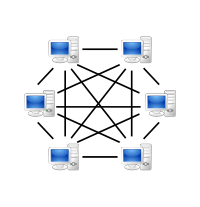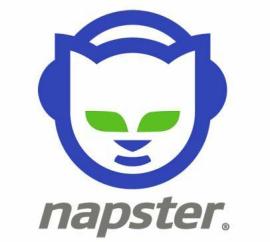Downloading Music and Videos
Group Members
- Nicole Marie Bonneau
- Hoang Anh Nguyen
Introduction
The availability of music and videos for download has increased over the years as the internet has become more accessible world wide. Globally from 2000-2008 internet usage increased 342.2 % with 23.8% population penetration as of March 31, 2009. Although in the same time period usage in North America only increased 132.5%, the population penetration was 74.4%. File sharing is the distribution of electronically stored material which includes computer programs and digital media such as music and videos. Canada actually has the highest number of file sharers per capita. Another factor that is responsible for the increased downloading of music and videos is the advancement in data compression. Music is most commonly compressed and encoded in MPEG-1 Audio Layer 3 format or commonly known as MP3. A popular codec that videos are encoded in is known as DivX which uses MPEG-4 compression. Although these two may be considered the most popular, there are others and all having the same goal, to reduce file size while maintaining quality of audio and video. Most audio tracks are about 5 to 10 Megabytes in MP3 format and full length movies in DivX format starting at about 700 Megabytes. Shaw currently offers high speed internet rated at 7.5 Megabits per second or 0.9 Megabytes per second so an audio track may be downloaded in about 5 to 10 seconds and a full length movie may be downloaded in about 700 seconds or about 12 minutes going at the full speed. Peer-to-peer or P2P file sharing is the most popular method of file sharing where users connect directly to each other or multiple users. Online streaming allows users to listen and view content over the internet without having to directly download it. A major concern however is the distribution of copyrighted material. Recently there have been more paid services available that do not violate copyright laws but still offer users the convenience of downloading or streaming of music and videos over the internet.
Download Sources
P2P
P2P are programs which users download and install that act as both clients and servers. With the program users are able to connect to other users using the program over the internet to share files with each other. These programs are typically available for free with some providing advanced versions for a fee. P2P programs were commonly known for the sharing of MP3 music files but have evolved to include other music formats, videos and software.
Napster
Napster was probably the most well known music file sharing program that kick started file sharing. It was created by Shawn Fanning and started operating in June 1999. At the peak of usage there were 26.4 Million users in February 2001. Due to legal issues Napster was forced to shut down in July 2001. Today the Napster brand and logo exists but no longer operates as a P2P program but does offer music for a monthly fee.
After Napster
After the fall of Napster, new P2P programs emerged. Programs such as Kazza, Limewire, Bearshare took what Napster started one step further and included the transfer of videos and other files such as software. These new P2P programs were not able to escape criticism or similar legal issues faced by Napster. All three programs still currently operate, but like Napster not a true P2P program. Kazza now provides unlimited music downloads for monthly fee. Limewire still offers P2P features but in conjunction with its LimeWire Store that offers single songs for purchase or subscriptions as well. Bearshare also offers paid music for download. There are however unofficially modified versions of Kazza and Bearshare called Kazza Lite and Bearshare Lite that users use to share files over a P2P network.
Chat Programs
Programs such as MSN Messenger, Yahoo Messenger, ICQ, and IRC are all chat designated programs. They may however be considered P2P because they all offer file transferring where users can send each other files such as music and videos. Other than IRC, users are not able to search and download songs like true P2P programs.
BitTorrent
Currently BitTorrent is the most popular P2P file sharing protocol with estimates of it accounting for 18-35% of the internet traffic. BitTorrent is a bit more complicated than previous P2P programs because to share a file a torrent must be created. The torrent contains information about what and where to download the file. Users wanting to download these files will typically have to download a BitTorrent client and find the specific torrent usually shared on different websites. Once the torrent has started, the user is connected to other peers with the same torrent open and will also be sharing the file.
Streaming
There are websites that allows users to simply watch videos or listen to music in their web browsers. Most of these websites require the user to just have Adobe Flash Player installed for watching videos. For other plug-in needed the web browser may automatically install it or detailed instructions are available on the webpage. There are some websites that allow users to download the content as well. Although the intention was to share user made videos, music videos and movies can be found.
YouTube
The most well known video sharing website is probably YouTube that was founded in February 2005 and launched in November 2005. Registered users are able to upload and comment on videos, while unregistered users can still watch videos. Since YouTube there has been many other websites as well like YouTube such as Veoh, Yahoo Video, and Google Video which parent company Google Inc. acquired YouTube in October 2006.
TV Networks
Major US TV networks like ABC, CBS, FOX, NBC, and PBS have been providing an extensive selection of their current network shows. For music videos users can watch them off sites like MTV.com. Unfortunately the US sites only allows users in the US to view them. Recently major Canadian networks like CBC, CTV, and Global have been providing limited selection of full episodes aired on their networks. For music videos users can watch them from MuchMusic or MTV.ca and one of its affiliates.
Internet Radio
With the internet users no longer have to be within the radio transmitter of the radio station if they want to listen to a specific radio station. Most radio stations now offer users to listen to their station directly off their website. Some stations use SHOUTcast developed by Nullsoft which requires user to listen using a program such as Winamp also developed by Nullsoft. There are also many independent SHOUTcast servers that users can connect and listen to or users can make their own internet radio broadcast. Aside from listening, there are methods for users to record the content from the internet radio stations.
File Hosting
File hosting services offers online storage of data to users. Users may find music and videos uploaded to some of these file hosting sources typically posted on other websites. Since storage is not free, file hosting services normally limit size and speed to users trying to download. Two popular services called Megaupload and RapidShare offers extended services with faster download speeds and larger daily or monthly limits for users to who pay.
Paid Services
iTunes
Apple Inc. has dominated the portable media player market since its release. iTunes is the software provided by Apple that allows users to transfer audio and video files to their iPod. iTunes can also be used as a media player and comes standard on Apple computers. Also with this program users can access the iTunes store where music, movies, and TV shows are available for download for a fee.
Netflix
In addition to offering DVD rentals over the internet and delivered by mail, Netflix also offers users the ability to watch movies streamed online on their computer or with a Netflix ready devices such as a Microsoft XBOX 360 or certain media players for the same monthly fee. Although Sony decided not to use Netflix with their Playstation 3, they do offer movies to be purchase and downloaded as well over their own Playstation Network.
Issues
Copyright Infringement
Excerpt of Copyright Act of Canada: (4) The owner of the copyright in any work may assign the right, either wholly or partially, and either generally or subject to limitations relating to territory, medium or sector of the market or other limitations relating to the scope of the assignment, and either for the whole term of the copyright or for any other part thereof, and may grant any interest in the right by license, but no assignment or grant is valid unless it is in writing signed by the owner of the right in respect of which the assignment or grant is made, or by the owner's duly authorized agent.
The unauthorized transfer of copyrighted materiel is the main reason for criticism and lawsuits against P2P networks.
Loss Revenues
Both the music and movie industry have reported losses due to free downloading instead of purchasing of their content. According to a paper by Alejandro Zentner published in 2005, music sales has dropped $38 billion since 1999 to 2003, coincidently Napster launched in 1999. The MPAA reported on May 31, 2006 that $2.3 billion was lost alone by American studios because of illegal downloading of movies in 2005.
Industry Fights Back
Due to copyright infringement which ultimately is leads to decrease in music and movies sales, the industry has fought back. The most well known and maybe first major case was against the pioneers of P2P illegal downloads Napster. Lawsuits were filed against Napster by artists like Metallica, Dr. Dre, and several recording studios. The courts ruled Napster was guilty for three counts of copyright infringement and they were forced to shut down in July 2001. Those who have tried to follow the footsteps of Napster and fill their shoes such as Kazza, Limewire, and Bearshare also have had their share of legal troubles and are now offering along with Napster legal paid services. The industries biggest battle currently is against BitTorrent sites. There have been lawsuits filed again websites such as Torrentspy, Isohunt, and The Pirate Bay. The Pirate Bay even had their servers raided by Swedish Police on May 31, 2006. Despite these legal issues, most of these sites are still fully operational. Users have felt relatively safe by downloading illegal material but there has been cases where the music and movie industry have targeted users. One such case was against Jammie Thomas from Minnesota who was charged $220 000 for online music sharing.
Unwanted content
Another concern users face when downloading material off the internet is getting unwanted items such as adware, spyware, and viruses. Some of these have been reported to be bundled with the P2P programs themselves. Another way is the download files themselves are infected. Users may find them selves getting unintended pornography, music and movies as a result from files being renamed on purpose. Sometimes the files are simply just bad files that do not work.
Conclusion
P2P networks and the internet in general have provided an ideal medium for the unauthorized distribution of copyrighted material. It has been an on going battle between the music and movie industry with the providers and users of such services. Although the industry have been successful in shutting down services like the iconic Napster new services emerge and another battle ensues. Currently the biggest threat for the industry is BitTorrent websites and its users. Without radical changes to the law and its methods, it comes down to changing the habits of the end user. However progress has been made with the rise of legal service such as iTunes and Netflix. Although illegal downloads is still a major issue, it has brought out services which are cost effective and convenient for users seeking legal alternatives over the traditional methods of obtaining media.
References
http://www.internetworldstats.com/stats.htm
http://www.oecd.org/dataoecd/13/2/34995041.pdf
http://en.wikipedia.org/wiki/MP3
http://en.wikipedia.org/wiki/DivX
http://www.shaw.ca/en-ca/ProductsServices/Internet/High-Speed/
http://en.wikipedia.org/wiki/Peer-to-peer
http://en.wikipedia.org/wiki/Napster
http://www.kazaa.com/
http://www.limeiwre.com/
http://www.bearshare.com/
http://www.multichannel.com/article/87516-BitTorrent_s_Swarms_Have_a_Deadly_Bite_On_Broadband_Nets.php
http://www.dslreports.com/shownews/56403
http://en.wikipedia.org/wiki/YouTube
http://www.bepress.com/bejeap/topics/vol5/iss1/art21/
http://www.cbsnews.com/stories/2007/10/04/national/main3330186.shtml
http://www.mpaa.org/press_releases/2006_05_31.pdf
http://en.wikipedia.org/wiki/File_sharing
http://www.cb-cda.gc.ca/info/act-e.html





